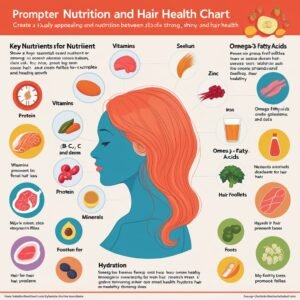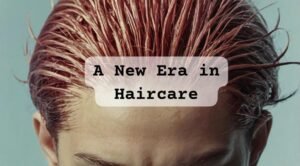The Application of AI for Preventing Hair Loss: The Era of Personalized Hair Treatment
Hair loss is a condition which plagues millions of people across the globe. It can be brought about by a number of reasons ranging from genetics, aging, hormonal imbalance, stress, diet, and exposure to environmental situations. In spite of decades of traditional therapy in the form of medications, hair transplantation, and over-the-counter medications, new directions are surfacing through technological advancements to eliminate this ancient disease. Artificial Intelligence (AI) is among the most promising emerging technologies that are transforming the process of understanding, preventing, and treating baldness. In this article, we clarify the application of AI to fight hair loss and how it is remaking the future of hair care. Understanding Hair Loss and Its Causes
1) Androgenic Alopecia: Or pattern or male and female baldness, a genetic disorder that results in hair thinning and loss.
2) Telogen Effluvium: Baldness which is most commonly brought about by stress, illness, drugs, or endocrine imbalance.
3) Alopecia Areata: Autoimmune condition where the body attacks its hair follicles and results in sudden, patchy baldness.
While genetics is the strongest causative factor in baldness, external influences like lifestyle, nutrition, and environmental stresses can serve to accelerate the process. It is here that AI enters the scene, with customized interventions for preventing hair loss and stimulating hair growth.
How AI is Revolutionizing Hair Loss Prevention
Use of AI in hair loss prevention is widespread and wide-reaching. Ranging from diagnosis of the cause of hair loss to recommending customized treatment, AI is transforming the way we deal with hair care.
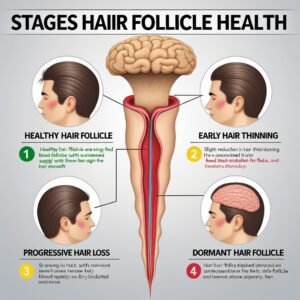
A few of the most important ways AI is preventing hair loss are outlined below:
1. Personalized Hair Loss Diagnosis
Artificial intelligence-based computer systems can screen for a variety of reasons such as genetic predisposition, diet, lifestyle, and environmental stresses and show an overall image of the hair condition of a person. AI can analyze images of a human scalp and hair using deep learning models and identify thinning, follicle health, and signs of baldness.
Through the support of AI fused with scalp imaging technology, the dermatologists are able to detect hair loss diseases with exact accuracy and make suggestions customized for an individual. The predictive analytics method comes handy particularly to identify loss of hair when it has commenced its occurrence stages that can perhaps not be discovered using normal identification practices.
2. Predictive Analytics for Early Detection
AI models can track the trend of hair health over time and predict when a person will most likely begin losing hair or thinning. With age, genetics, diet, and other behavioral data collection and analysis, AI can create predictive models so that people can take preventive measures before they begin losing hair.
For instance, using AI, one can predict the chances of getting androgenic alopecia depending on genes and other characteristics. All early treatments like modifying one’s diet or starting preventive treatment cycles will be capable of curing or reversing the baldness condition.
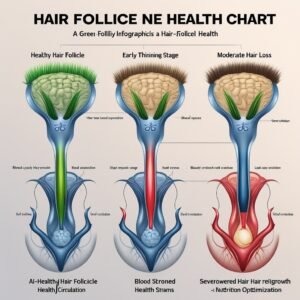
3. AI-Guided Hair Care Products and Treatments
AI is also developing very individualized hair care products according to individual needs. AI develops bespoke design of shampoos, conditioners, and topical treatment solutions according to individual hair conditions and types. Active ingredients of the product are selected to target the underlying cause of hair loss, e.g., DHT reduction for patients with androgenic alopecia or anti-inflammatory drugs in alopecia areata.
Furthermore, AI-intelligent devices like scalp massagers or laser therapy combs may individualize hair restoration treatments. Such devices leverage AI technology in monitoring the dynamic hair and scalp condition in real-time and tweaking treatment accordingly and providing the best treatment to the user.
4. AI-Based Hair Transplants
Hair transplantation has been everyone’s favorite choice option for a long-term solution for baldness.
While the process is expensive and invasive, AI has made it less invasive, precise, and quicker.
There is advanced AI technology that can actually scan the scalp to find out where the best places are for hair follicle transplantation and implantation to occur. This makes the hair transplant procedure more effective and also brings access to prospects who would otherwise have avoided the procedure. Besides, AI allows better after-transplantation care by monitoring healing and suggesting individualized aftercare based on one’s requirements to maximize the outcome.
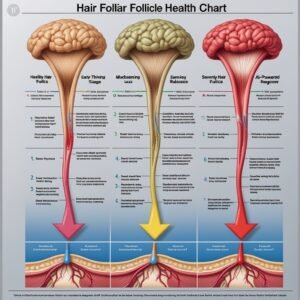
5. AI in Hair Regrowth Solutions
Now hair growth treatment without surgery is possible with the help of AI, such as light therapy-based customized treatment, platelet-rich plasma (PRP) therapy, and topical treatment. Depending upon the condition of one’s scalp, AI can personalize the treatment to maximize the outcome.
AI also fuels the development of drugs and treatments that are formulated to stimulate hair growth. For example, AI can sort through vast amounts of information to determine which chemicals are most likely to wake up dormant hair follicles and promote regrowth.
The Future of AI in Hair Loss Prevention
The possible future of baldness prevention remains to be seen with the aid of AI but it can reach any boundary. As the algorithms of AI get more developed, diagnosis precision and treatment efficacy will continue to better. Soon AI-driven tailor-made hair care will be common and give specific recommendations that would fit each and every person.
In the near future, AI might also find applications in wearable technology that monitors hair health all the time and provides real-time analysis and recommendations. Further, the drug discovery potential of AI might lead to revolutionary hair loss remedies that were once inconceivable.
Also, as increasingly more people are becoming aware of the potential for AI in the world of hair care, utilization of such technology will continue to increase. The union of treatments, data analytics, and AI is transforming the future of hair care, and the dream of avoiding hair loss is closer than ever before.
Conclusion
AI is at the forefront of avoiding and treating hair loss.
With the offer of personalized diagnosis, early detection, and tailored treatment programs, AI is transforming how we approach treating hair care. reversing hair loss or a different approach to addressing it, AI is helping to drive the creation of new solutions with the ability to flip the script for those battling this vastly common condition.


